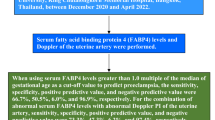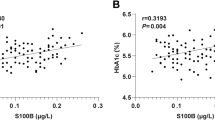Abstract
Objective
The aim of this study was to estimate the level of liver fatty acid binding protein (LFABP) in women with preeclampsia.
Method
A case–control study was conducted in 90 pregnant women who were divided into the following three groups: normal pregnancy (n = 30), mild–moderate preeclampsia (n = 30), and severe preeclampsia (n = 30). Maternal blood samples were obtained during an antenatal clinic visit in normal pregnant women, and at the time of diagnosis in women with preeclampsia. Serum LFABP levels were measured by the quantitative sandwich enzyme immunoassay technique.
Results
Serum LFABP level was significantly higher in severe and mild–moderate preeclampsia groups than normal pregnancy group (1,709.90 ± 94.82, 1,614.93 ± 118.22, and 1,532.36 ± 140.98 pg/ml, respectively; p < 0.001). In multivariate analysis, the severity of preeclampsia was correlated with LFABP level [unadjusted odds ratio (95 % confidence interval), 1.008 (1.003–1.012), p < 0.001 and LDH 1.063 (1.029–1.099), p < 0.001].
Conclusion
Maternal serum LFABP level appears to be correlated with the severity of the preeclampsia and can be used to confirm the diagnosis.
Similar content being viewed by others
References
El Beltagy NS, El Deen Sadek SS, Zidan MA et al (2011) Can serum free fatty acids assessment predict severe preeclampsia? Alex J Med 47:277–281
Can M, Sancar E, Harma M, Guven B, Mungan G, Acikgoz S (2011) Inflammatory markers in preeclamptic patients. Clin Chem Lab Med 49:1469–1472
Chelbi ST, Veitia RA, Vaiman D (2013) Why preeclampsia still exists? Med Hypotheses 81:259–263
Yalcin S, Ulas T, Eren MA et al (2013) Relationship between oxidative stress parameters and cystatin C levels in patients with severe preeclampsia. Medicina (Kaunas) 49:118–123
Engin-Ustün Y, Ustün Y, Karabulut AB, Ozkaplan E, Meydanli MM, Kafkasli A (2007) Serum amyloid A levels are increased in pre-eclampsia. Gynecol Obstet Invest 64(2):117–120
Toy H, Camuzcuoglu H, Arioz DT et al (2009) Serum prolidase activity and oxidative stress markers in pregnancies with intrauterine growth restricted infants. J Obstet Gynaecol Res 35:1047–1053
Villa PM, Laivuori H, Kajantie E et al (2009) Free fatty acid profiles in preeclampsia. Prostaglandins Leukot Essent Fatty Acids 81:17–21
Scifres CM, Catov JM, Simhan H (2012) Maternal serum fatty acid binding protein 4 (FABP4) and the development of preeclampsia. J Clin Endocrinol Metab 97:E349–E356
Chaemsaithong P, Chaiworapongsa T, Romero R et al (2014) Maternal plasma soluble TRAIL is decreased in preeclampsia. J Matern Fetal Neonatal Med 27:217–227
Atshaves BP, Martin GG, Hostetler HA et al (2010) Liver fatty acid binding protein and obesity. J Nutr Biochem 21:1015–1032
De Gerónimo E, Hagan RM, Wilton DC et al (2010) Natural ligand binding and transfer from liver fatty acid binding protein (LFABP) to membranes. Biochim Biophys Acta 1801:1082–1089
Lehnen H, Mosblech N, Reineke T et al (2013) Prenatal clinical assessment of sFlt-1 (Soluble fms-like tyrosine kinase-1)/PlGF (Placental growth factor) ratio as a diagnostic tool for preeclampsia, pregnancy-induced hypertension, and proteinuria. Geburtshilfe Frauenheilkd 73:440–445
Alexander GR, Himes JH, Kaufman RB et al (1996) A United States national reference for fetal growth. Obstet Gynecol 87:163–168
ACOG Committee on Obstetric Practice (2002) ACOG practice bulletin. Diagnosis and management of preeclampsia and eclampsia. Int J Gynaecol Obstet 77:67–75 (Number 33, January 2002. American College of Obstetricians and Gynecologists)
Sasaki H, Kamijo-Ikemori A, Sugaya T et al (2009) Urinary fatty acids and liver-type fatty acid binding protein in diabetic nephropathy. Nephron Clin Pract 112:c148–c156
Ozenirler S, Erkan G, Gulbahar O et al (2011) Serum levels of advanced oxidation protein products, malonyldialdehyde, and total radical trapping antioxidant parameter in patients with chronic hepatitis C. Turk J Gastroenterol 22:47–53
Basak S, Das MK, Duttaroy AK (2013) Fatty acid-induced angiogenesis in first trimester placental trophoblast cells: possible roles of cellular fatty acid-binding proteins. Life Sci 93:755–762
Foucaud L, Grillasca J, Niot I et al (1999) Output of liver fatty acid-binding protein (L-FABP) in bile. Biochim Biophys Acta 1436:593–599
Thompson J, Ory J, Reese-Wagoner A et al (1999) The liver fatty acid binding protein–comparison of cavity properties of intracellular lipid-binding proteins. Mol Cell Biochem 192:9–16
Thompson J, Reese-Wagoner A, Banaszak L (1999) Liver fatty acid binding protein: species variation and the accommodation of different ligands. Biochim Biophys Acta 23:117–130
Lagakos WS, Guan X, Ho SY et al (2013) Liver fatty acid-binding protein binds monoacylglycerol in vitro and in mouse liver cytosol. J Biol Chem 288:19805–19815
Akbal E, Koklu S, Cakal B, Gunes F, Basar O, Tuna Y, Senes M (2013) Liver fatty acid-binding protein is a diagnostic marker to detect liver injury due to chronic hepatitis C infection. Arch Med Res 44:34–38
Robinson NJ, Minchell LJ, Myers JE et al (2009) A potential role for free fatty acids in the pathogenesis of preeclampsia. J Hypertens 27:1293–1302
Shangguan X, Liu F, Wang H et al (2009) Alterations in serum adipocyte fatty acid binding protein and retinol binding protein-4 in normal pregnancy and preeclampsia. Clin Chim Acta 407:58–61
Zar T, Kohn OF, Kaplan AA (2011) Fractional excretion of urea in pre-eclampsia: a clinical observation. Iran J Kidney Dis 5:398–403
Conflict of interest
The authors have no conflict of interest.
Author information
Authors and Affiliations
Corresponding author
Rights and permissions
About this article
Cite this article
Uzunlar, O., Engin-Ustun, Y., Ozyer, S. et al. Is there an association between liver type fatty acid binding protein and severity of preeclampsia?. Arch Gynecol Obstet 291, 1069–1074 (2015). https://doi.org/10.1007/s00404-014-3540-x
Received:
Accepted:
Published:
Issue Date:
DOI: https://doi.org/10.1007/s00404-014-3540-x




